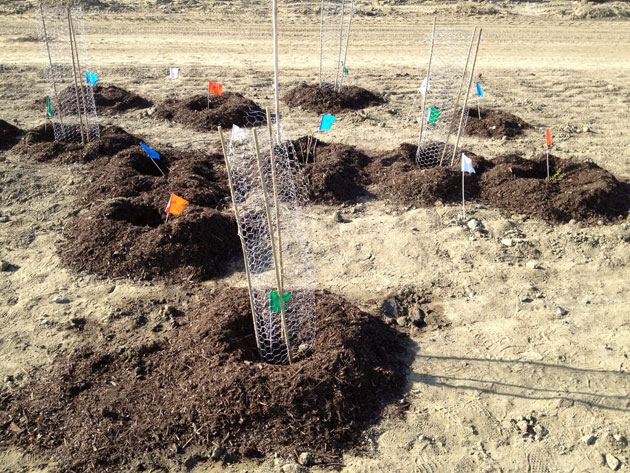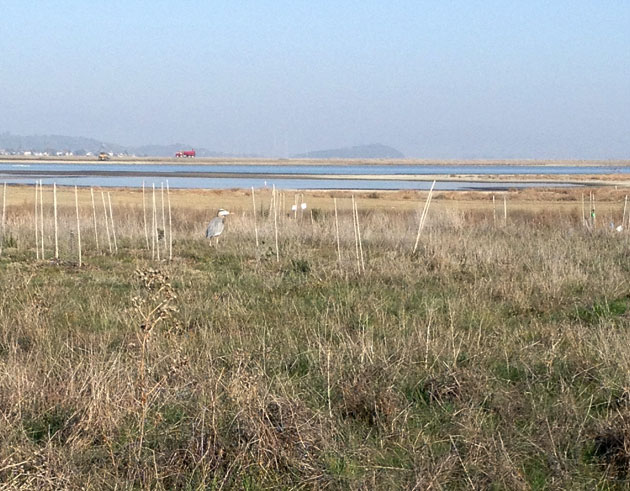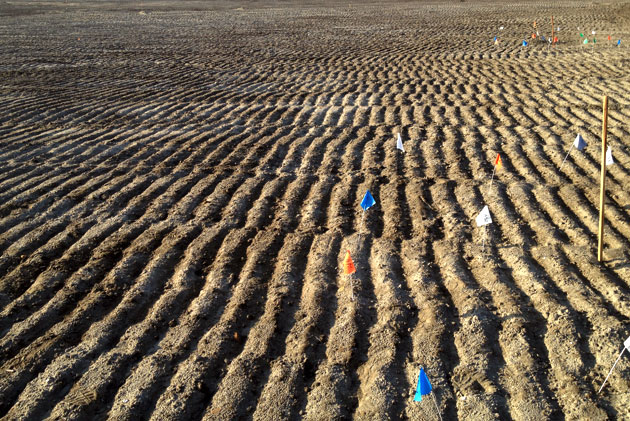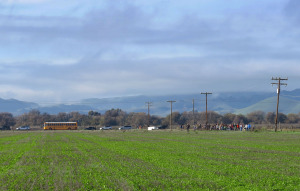Give it a decade or two and the former Hamilton Airfield will be one of the most magnificent outdoor spaces in the Bay Area: several hundred acres of upland, lowland and tidal marsh habitat, dotted with oak and buckeye, bursting with toyon and snowberry, carved by tidal channels, and bordered by a trail and viewing stations.
But right now it is really a very magnificent amount of dirt. Buried under 5.6 million square yards of dredged mud, the land that was once a military airport lies in undulating brown rows, stretching out from suburban housing development to the water’s edge. In a few months, the levee separating the mud from the Bay will be breached, allowing the tides to once again wash the marsh. But again, right now, extraordinarily high-potential dirt.
Christina McWhorter, a botanist at the Hamilton Nursery who is helping to raise the 60,000-some-odd plants that will one day fill this blank slate, looks at the dirt and sees the future. “It’s going to be pretty neat,” she says. There will be a mix of brush and trees, a “tapestry,” she says. There will be a 27-acre wildlife corridor fringing a new section of Bay Trail, and near the water’s edge several hundred acres of tidal wetlands. In between the tidal wetlands and the wildlife corridor will be a transition area of grindelia and juncus brush, McWhorter says, a “beautiful sinuous border between lower elevation wetland and higher elevation upland planting.”
On a recent Friday morning, you could see at least a part of that vision mapped out precisely on the ground in dozens of clumps of colored flags. These are “restoration polygons,” precise instructions for what plants to stick in the ground where. Each 214-square-foot restoration polygon consists of 16 plants, each plant in the polygon arranged in a certain spatial orientation with notes on depth and composition of substrate that McWhorter can return to to learn about what causes things to succeed or fail in replanting.
The precision is useful, not just scientifically but because on this Friday the job of implementing the polygons fell to several dozen reasonably enthusiastic middle schoolers from Hamilton School and Todd Adams’ 7th grade science class. This might be one of the cooler elements of the entire project: Several thousand of the 60,000 plants intended to go into the ground will arrive there via the hands of young Marin residents as part of the Students and Teachers Restoring a Watershed Program, part of Point Blue Conservation Science. STRAW has been working on restoration projects around Marin for two decades, and helping at Hamilton for the last few years.
Emily Allen, a project manager who joined the program as a STRAW intern about 10 years ago, knows the value of a decade. When she first started, she says, her coworkers would say, “There’s this big restoration project at Hamilton and someday you’ll get to see it.” Allen remembers thinking, “Yeah, right.”
Now, the restoration project is underway, and Allen is the one telling her charges to dream big.
“One of the kids was like, ‘It’s a wasteland out here’,” Allen says. “But I said, ‘Can you imagine it in 10 years?’”
Most of the kids can. Their delight at being out of school doesn’t entirely hide the fact that the kids can connect to watersheds and wetlands in a fundamental way. Many of them live nearby, many of them have explored the area in its previous incarnations. Friday morning, as the students walked out to the restoration site, one boy broke away to tell Allen that he remembered building rock forts on the old airfield.
Allen said she intended to shepherd about 1,000 plants into the ground over the course of a few high-activity weeks, with 400 students from second to seventh grade involved in the planting.
“We could just be a restoration crew,” she says. “But the STRAW idea is to let the kids have a real project, and make that real connection to their community.”

It’s a meticulous process: before the kids arrive STRAW workers and biologists from the Army Corps of Engineers lay out the polygon shapes and mark the spot for each kind of plant with a different-color flag. Then the students work in small groups to dig the hole, shoot the plant into it, water, and edge with mulch. The flags remain for McWhorter to study survivability, which so far in previous plantings is an “acceptable” 50-75 percent, she said.
The students, meanwhile, have had to do their homework. They’ve taken classes on the project, wetland habitats, and endangered species. They know their clapper rails and salt marsh harvest mice.
The product at the end of the day looks more like a gopher warren than a restored marsh. Clusters of mulch donuts seem to lie haphazardly across the dirt. But around the corner, at the site of last year’s planting, you can see the mosaic of upland habitat starting to take root. While many of the plants are dormant for the winter, a great blue heron stalks through year-old vegetation.

The kids take off for the day after lunch, their hands scrubbed somewhat free of marsh mud. But they’ll be back, sometimes even immediately so. Allen says that after one recent planting, she saw a few kids hop the wall separating the still-under-construction marsh from nearby homes. An adult followed them over the wall shortly afterward. Allen says that while it’s not really her job to enforce the rulebook, she was about to go say that the area wasn’t open yet — and then the kid yelled, “Mom, look, that’s our mulch!”
—
To find our more or volunteer with the Hamilton Nursery, see this post from the State Coastal Conservancy. For more information about the volunteer planting effort or other student-teacher restoration opportunities in Marin, check out the STRAW web page.




